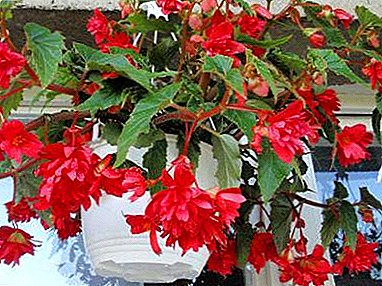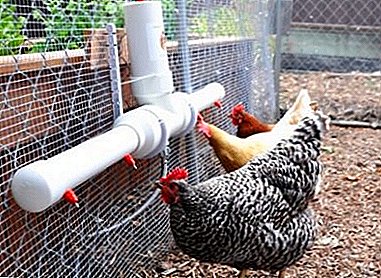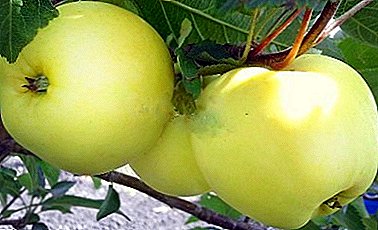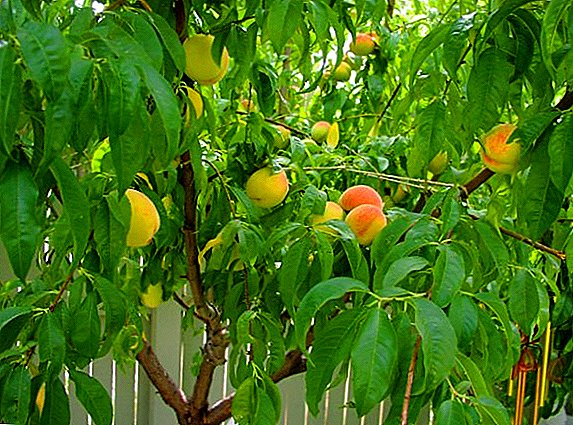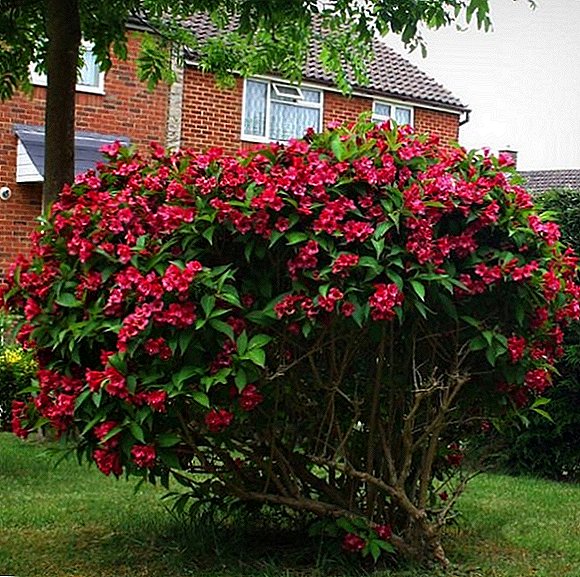 Weigela is a flowering perennial shrub that is valued for its spring and summer ornamental flowers. Their aroma resembles the smell of honeysuckle. Often planted in the form of hedges, these plants do not require special care, but still need to take care of them. Preparing the weigel for winter will help her survive the cold with minimal damage.
Weigela is a flowering perennial shrub that is valued for its spring and summer ornamental flowers. Their aroma resembles the smell of honeysuckle. Often planted in the form of hedges, these plants do not require special care, but still need to take care of them. Preparing the weigel for winter will help her survive the cold with minimal damage.
Cold resistant varieties
Weigela plant (Latin name Weigela) is a genus of deciduous shrubs belonging to the honeysuckle family. In botany, 15 species of weigel are known. Habitat - Asia (east and south-east).
In the Russian Federation, this plant is often found in Primorsky Krai. Three species grow there: Weigela early (Weigela praecox), Weigela Middendorfa (Weigela middendorffiana) and Weigela pleasant (Weigela suavis).
The bush blooms twice a year - from the second decade of May to June 15-20 and from August 20 to the first of October. At this time, the plant is covered with funnel-shaped flowers. Secondary flowering is not as beautiful as in spring or in June, when the branches are completely covered with flowers of all shades from white to purple.
Video: varieties and types of weigela The color of just opened petals is lighter than that of beginners fading. For example, a white flower, fading, becomes pink or purple.
Important! The gardener needs to remember that even with good frost resistance weigela should be covered from winter frosts whenever possible. If a lot of snow falls in the growing region in winter, the plant can be covered with snow (on top of the branches and ground laid on the ground in the root zone).
The most cold-resistant varieties of weigel
Residents of the northern edges, where winter can be harsh, should first of all pay attention to such characteristics of the Weigela species as the ability to tolerate cold.
- Weigela Middendorf - a plant up to one and a half meters high, with directly growing stalks. Leaves are green, slightly fleecy. The flowers are yellow, with a more brightly colored center, have the appearance of an inverted bell, grow one by one and collected in bunches of 2-6 flowers on a common stem. The plant blooms twice in spring and autumn. Flowering lasts for thirty days. Frost resistance to -15 ° C.
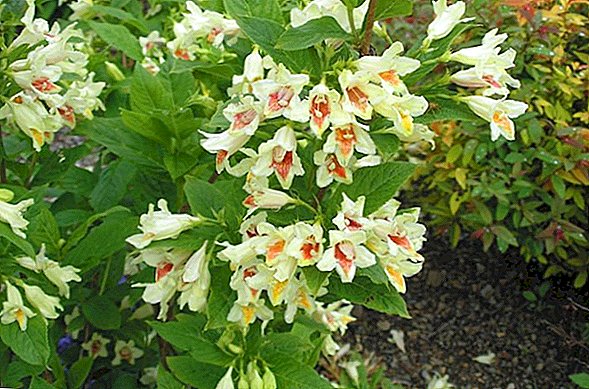
We recommend that you familiarize yourself with the description of species and varieties of weigela, as well as learn how to grow weigela bushes on your site.
- Japanese weigela - shrub up to 1 meter. The leaves are elliptical or ovate, 5 to 10 cm long, the shape of the sheet is toothed, pointed to the top. Leaves to the touch slightly fleecy. Funnel-shaped flowers, flower length 2-3 cm, carmine color. The view is very decorative and very much appreciated by gardeners, but it requires a small winter shelter, since the branches may already suffer during frosts of -13-15 ° С.

Did you know? Weigel shrubs are often used in landscape design to create decorative flowering hedges. They not only decorate the garden, but also create a dense fence from unwanted visitors. Weigela has a lush bush and strong branches, which, growing, intertwine with growing in the neighborhood plants and form almost impassable thickets.
- Weigela nice - shrub grows in the Far East. The height of the shoots is up to 1.3 m. The leaves are elongated, green, smooth on top, the bottom plate of the sheet is fleecy to the touch. Flowers funnel-shaped, burgundy from the outside and light pink from the inside. Flowers are located on the side branches. The size of the flower is from 2 to 5 cm. The plant blooms from May 15-20 until mid-summer, closer to autumn secondary flowering occurs - from August 15-20 until the beginning of October. The view has good frost resistance.
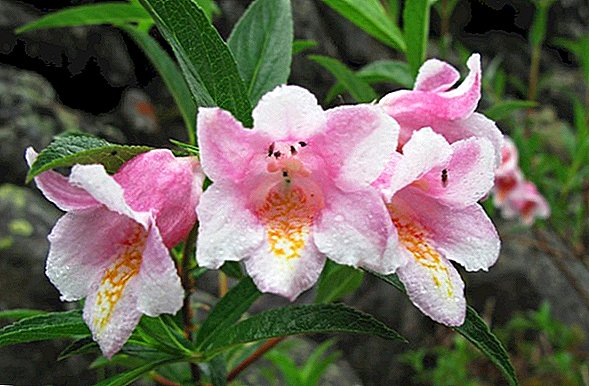
- Weigela early - the variety is widespread in the Ussuri region, in China and on the Korean Peninsula. The height of the bush is up to 1.5 m, the width of the bush reaches two meters. Flowers are extremely decorative, grow one at a time or collected in bunches of two or three flowers. Flowering occurs on short young branches. The color of the flowers is pink on the outside and burgundy on the inside; sometimes there is a variety with a cream center. It blooms from late May to June for a month. It is widely used in landscape design for single or group planting, also used to create hedges. Frost resistance to -15 ° C.

Did you know? The name weigela is given to the shrub in honor of the German professor of chemistry and botany, Christian Ehrenfried von Weigel (1748-1831).
- Weigela Maksimovich - height 1.5 m. Fleece sheet, 4-8 cm, elongated, pointed to the tip. Bell-shaped flowers up to 3.5 cm, painted in light yellow color and arranged on short branches. In the European climate, weigela Maksimovich blooms from May 15 to June 15-20. It can be grown as a covering and as a non-covering culture. Without shelter it can tolerate cold up to -10 ° С.
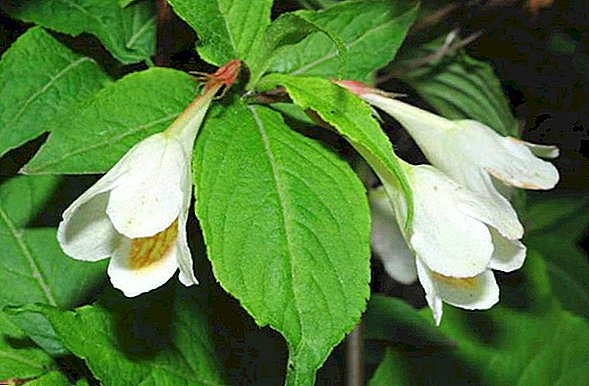
- Weigela blooming (Florida) - plant height up to 3 m, width 3.5 m. Bright green leaf cover lasts a long time on the branches and crumbles only with the arrival of the first frost. It blooms with large bells (2.5-3 cm), beet flowers at the edges and cream or white inside. Inflorescences are clustered on short side branches. Blossoms by May 30 or early June. The flowering weigela has varieties with unusual multi-colored foliage. Frost resistance is average.

Your garden will be beautifully decorated with flowering shrubs such as broom, budley, calmia, heather, rhododendron, hibiscus, hydrangea, jasmine, silverweed, camellia, magnolia, lilac, spirea, forsythia.
Popular varieties
Among the wide variety varieties of weigel, there are several frost-resistant or relatively frost-resistant varieties, which are especially beloved by gardeners:
- Variety "Pink Princess" - a popular blooming variety, originally from China. It also grows in nature in Korea and Japan. This is a hardy plant that is easy to grow, it is undemanding in the care. The height of the branches is up to one and a half meters, the width of the bush is about the same. In the mild climate (Caucasus, Kuban, Crimea) can do without winter shelters.

- Variety "Purple" - height is up to 1,5 m with a dense cap of branches up to 2 meters. The leaves are elliptical, purple (6-8 cm). Beet flowers with a creamy sand core, favorably shaded by purple leaves. Blooms in June or July. Relatively cold-resistant variety, but in regions with cold, severe winters needs shelter.
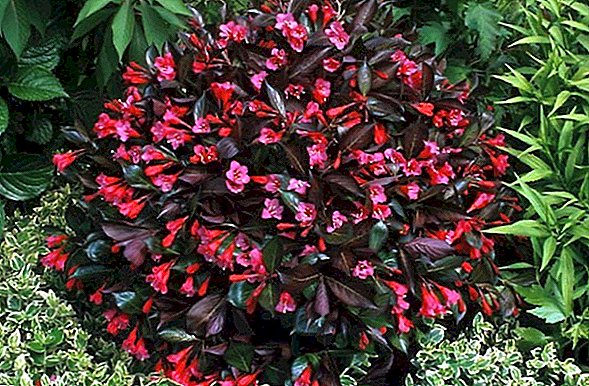
- Sort "Alba" - three-meter bush, cap width more than 3 m. Flowers are snow-white, in the form of a bell; blooming, the petals become pink. The leaf is green, ellipsoid, with a jagged edge. The upper part of the sheet plate is smooth, the bottom is rough. Frost resistance is average.

- Grade "Nana Variegata" - A bush with very decorative flowers and leaves. Lush one-and-a-half-meter plant with a rounded crown up to 1.2 m. On the green leaves there is a white or cream border around the edge, the leaf plate is toothed. Flowering begins from May 15 and lasts until June 15-20. Without shelter, it can withstand temperatures down to -12 ° C, therefore shelter is recommended in the northern regions.

Preparing for the winter
Even frost-resistant varieties need help and care to winter without problems.
Watering
A grower should not allow his plants to tolerate cold with a dry root system. In most regions of the country there is enough rain in the fall, so watering at the end of the warm season is not needed, but if there is not enough rainfall, good soil moisture before it freezes is simply necessary, especially for shrubs planted in the same year.
Although weigela is a shrub whose leaves fall in the fall, its roots continue to function for some time. Therefore, it is important to maintain good root growth during the fall, especially if the weigel shrub has recently been planted.
At this time, it is necessary to periodically water the shrub, supplying water to the roots whenever the soil seems to be dry to the touch. In addition, wet soil tends to remain warm and not frozen longer than dry soil, so autumn watering helps maintain soil heat.  Water wisely. If it rains often, the bush does not need to be watered. If the weather is dry, the plant should be watered weekly throughout the fall, before the onset of frost or snow.
Water wisely. If it rains often, the bush does not need to be watered. If the weather is dry, the plant should be watered weekly throughout the fall, before the onset of frost or snow.
Drip irrigation for weigela
Drip irrigation is a good way to provide shrubs with a slow flow of several liters of water per week.
Familiarize yourself with the advantages of using drip irrigation at the dacha, and also learn how to do drip irrigation from plastic bottles with your own hands.
Gardener can purchase it, or do it yourself:
- Take a plastic bucket of 5 liters.
- At the bottom of the bucket a hole with a diameter of 2-3 mm is made (with the help of a drill or a nail heated to fire).
- A device for watering (self-made or store) is located in the area of the root zone of the bush.
- Poured into the inside of 5 liters of water.
Fertilizer
Gardeners know that without regular fertilizer the ornamental shrub will not bloom.
To feed a plant in the middle of winter or in early spring, do the following:
- Cover the old mulch with a spade or chopper in the basal soil.
- Top with a thick layer of organic compost.
- Fertilizer should cover the root zone of the bush with a diameter of 1 meter.
We recommend that you familiarize yourself with the features of making compost yourself, and also find out whether it is worth preparing fertilizer in garbage bags.A good layer of compost will ensure the delivery of all the necessary nutrients to the roots. You can also buy a slow-acting fertilizer, specifically designed to support ornamental shrubs in the winter.
 A hardy plant does not require a lot of fertilizer, but enriched soil will give impetus to a more abundant and colorful spring flowering.
A hardy plant does not require a lot of fertilizer, but enriched soil will give impetus to a more abundant and colorful spring flowering.Mulch
Adding in the fall a layer of organic mulch (straw or crushed bark) in 10-15 cm helps to keep the soil moisture and makes the roots grow as long as possible.
In the northern regions, mulch also protects the root system from freezing and thawing cycles, which cause the earth to expand and contract. These cycles can squeeze the roots out of the ground into frost or damage them mechanically (by squeezing).
Keep the compost in the root zone of the shrub and keep the soil under the plant moist by mulching it with a layer of wood chips 5 or 7 cm over the compost. This woody mulch will help prevent weed growth under the shrub. But, at the same time, it is impossible to allow the mulch to come into contact with the bark of the shrub, as this may contribute to the decay of the weige. 
Trimming for the winter
Avoid pre-winter and winter pruning. In cold climates, pruning shrubs are best left until spring. Leaving the shrub intact, the gardener provides him with additional protection for the lowest but most important buds on the plant.
Winter pruning weakens the plant, making it vulnerable to freezing temperatures. Therefore, experienced gardeners are trying to move the autumn or winter pruning in the spring, when the injured pruning plant quickly comes to life and begins to actively grow young branches.
In addition, on the overwintered shrub, there may be frozen or dead branches that will be visible to the naked eye in the spring - that’s what the gardener will remove with the help of the shears in the first place. 
Pest protection
Insects are usually not a threat to plants in winter, but a number of rodents (mice, hares) can visit the garden in winter in search of food. Usually visits of rodents cause great damage to the bushes. Rabbits, mice and voles gnaw branches to get to the soft and moist layer under the bark.
Learn how to get rid of rodents in the house and garden (in particular from rats, voles and mice).
This type of damage is usually observed at the base of the plant, although in winter, when a lot of snow falls, you can see damage from the teeth along the branches, as the snow raises the animals to the vegetable "feeders".
If the garden is located in the area of frequent visits by these animals, it is recommended to additionally protect the plants. You can create a barrier around the plant from the net, or even wrap a bush with sacking. You can also use repellents from rodents, which are processed shrub.
Important! Ask the garden store for advice on which of the rodent repellents work best in your area. To obtain a stable and reliable effect, liquid repellents are used several times during the season.

Shelter for the winter
In addition to the procedures described above, the plant needs to provide reliable external protection against temperature changes.
Sunburn Cover
Since weigela has no leaves in winter, its stems are susceptible to sunburn, which occurs when the sun heats the bark on sunny, but cold and frosty days. The sun stimulates the activity of juices in the stem, which can cause damage to woody tissue, when a strong frost comes to replace the sun and the air temperature drops sharply.
Sunburns are mainly caused by young or recently transplanted shrubs growing on the unprotected south side of the garden. If a severe sunburn is obtained, dried, cracked bark or parts of the branches damaged by other means will be visually visible.
Video: how to cover plants for the winter Sunburn can be prevented by wrapping the largest branches of the weigela with agrofiber or by shading wood fences near the bushes.
If the shrub is thick and has only thin branches that are not easy to wrap, give some shading on the side facing the south, securing a cloth of black sackcloth or black agrofibre with a dozen ordinary clothes pegs or a thin rope on the weigel.
It will be useful for you to read about how to properly prepare for the winter hydrangeas, climbing roses, karyopteris, lilies and peonies.
Frost cover
The shrub is moderately sensitive to frost, but it will still be appropriate to cover it from the winter cold. It is necessary to fill the hill from the soil around the root zone of the plant, so that the roots do not freeze. In addition, old shrubs cope well with the cold, but it is desirable to cover young plants with dense agrotextile.
This will increase the likelihood that ornamental plants will not die in extreme cold. Covering wintering shrubs weigela can be in several ways. 
Method number 1
- Wrap a bush "in the waist" with thick twine and pull the branches together - carefully, but compactly.
- Wrap tight spunbond, burlap or agrofabric.
- Using a stapler or clothespins to secure the ends of the warming fabric so that the bush is in a warm case.
- In the root zone of the plant (up to 1 m in diameter) pour four or five buckets of soil or compost in the form of a gentle hill.
Method number 2 This method is suitable for young and flexible shrubs:
- The top of the bush with a string of twine.
- A plastic bucket, half filled with sand, is tied to one of the apical branches.
- After a few hours, the top of the shrub, lowered under the weight of the bucket, is fixed on the ground with a large wire “pin” or a pair of bricks and is tied with branches of the bush in several places with a string. As a result, we get laid on the ground "doctor sausage."
- The branches lying on the ground (as far as possible) are filled with soil brought from another part of the garden. The height of the soil, above the lying branches, should be about 30-40 cm.
- Pristvolny circle of the bush is also insulated with soil or compost. For a young bush enough 3 buckets.
What to do if dried or dry
It happens that in the spring the aerial part of the weigel bush is dry. In this case, the gardener assumes that his plant is withered or frozen out. For drying out, there are a number of possible causes, and before taking any action, you need to determine which of these causes applies to your plant.
The two main causes of winter drying are:
- root damage;
- lack of water.
In winter, the roots may suffer:
- from the lack of moisture in the soil;
- frostbite;
- from physical injury, being pushed to the surface by frost-thaw cycles and newly compressed frozen ground.

How to determine the cause of drying
Weigel bushes that have suffered badly during the winter can often be rehabilitated, they just need time to recover. To determine how to help the plant, carefully inspect the shrub and the soil under it.
If root damage is suspected, look for a possible injury site. If the roots are not injured, you need to gently try the ground for hardness with a shovel. If the soil is dry deeper than 5-10 cm - weigela bushes need water.
Возможные причины повреждения корней:
- Damage to the roots can be caused by treating the root zone with an iron tool (too deep or close to the plant). For example, some gardeners love to dig up the soil around the plant in the fall to remove weeds, and in the process accidentally damage the roots. This problem can be avoided if you regularly mulch the tree trunk.
It will be useful for you to read about why you need soil mulching.

- Other diligent gardeners damage the root system when working with pre-winter composting or manure into the soil under a bush. To avoid this, instead of embedding fertilizer, it is necessary to carry out a liquid fertilizing with compost or slurry solutions. This dressing does not require digging the soil.
- Finally, a glut of water or fertilizer can also damage plant roots. The root system rots, loses its ability to absorb water. Additional watering in this case may be similar to throwing firewood into the fire.
What to do
- If the soil under the plant is dry, which was promoted by a snow-free winter, then water the shrub well, but do not overwet it. At one time you need to make no more than 5 liters of water, and repeat watering (in dry weather) twice a week for a month.
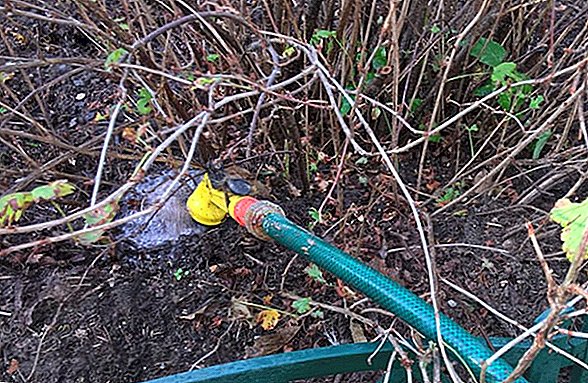
- If the roots of the plant were damaged (regardless of the source of the damage), they should be given time to recover. It is better not to water the damaged root system at all, but to keep residual moisture in the soil, cover the tree trunk with mulch.
- With good care, the affected weigel shrub will recover in about a month, and may even throw out flowers this spring.
Important! Water supply to the root system when the roots are unable to absorb water, at best - useless action, at worst - the reason for the beginning of the decay of the roots.
Spring care
When the cold has receded, you can begin active care of the plant.
Spring pruning
Although weigela is a hardy plant, it can suffer from freezing, especially in areas with harsh winters. Therefore, at the end of winter landing you need to inspect and cut off all the affected (dead) branches.
We advise you to read about how to choose a pruner for the garden.
A visual inspection will show visible stems on which buds did not grow. Such dead branches on the cut will be dry and black, they must be cut with a secateur until light, live wood begins.  Thanks to this procedure, the plant will recover faster after winter and increase new shoots. If it is not too clear, live branch or not - you need to scratch its bark with a fingernail. When it turns out that woody tissue (sapwood) under the bark is greenish-white - the stem is healthy; dry cloth indicates that the branch died.
Thanks to this procedure, the plant will recover faster after winter and increase new shoots. If it is not too clear, live branch or not - you need to scratch its bark with a fingernail. When it turns out that woody tissue (sapwood) under the bark is greenish-white - the stem is healthy; dry cloth indicates that the branch died.
Remove dead branches using a sharp garden pruner or a special pruning knife. Blades of tools should be wiped with alcohol before each cut to prevent the spread of disease.
If necessary, you can remove the damaged or frozen branches at the end of winter, but to keep the flower buds, experts recommend to move this procedure to spring. If the shrub is old and heavily overgrown, you can rejuvenate it by removing several large branches at the end of winter.
Cut them near the base of the bush so that the light penetrates into the undergrowth, this will contribute to the formation of new shoots. Old thick branches may have to be removed with a garden saw, as the pruner will not cope with such rough wood.
Video: Wiigel Care
Time to trim
Spring pruning of a weigel shrub is best done after the plant has faded. Therefore, in the spring you need to enjoy the lush flowering of decorative weigela until it is completely finished, and then pruning. If you cut the plant too early (before flowering), it can adversely affect the ability of the shrub to fully bloom next year.
Important! Weigel flower buds are laid on annual branches. This means that next year such branches will bloom profusely. If the gardener waits for the flowering shrub to start pruning, it will be easier for him to determine from which drying flowers which branches can be cut and which need to leave to bloom next year.
Spring dressing
Early spring fertilizers need to be applied under the weigela to give the shrub weakened over the winter strength to grow and bloom.
- The procedure is carried out in early spring, before the snow melts.
- Top dressing crumbles into the snow lying under a bush.
- Together with the melting snow, the fertilizer will gradually be absorbed into the ground, going straight to the roots of the plant.

Ingredients:
- 20 g of urea;
- 10 g of superphosphate;
- 10 g of potash fertilizer.
How to use:
- All components of mineral fertilizers are mixed in a dry form.
- The mineral mixture consisting of the above-mentioned amount of ingredients is scattered under the bush, covering the root zone of the plant with a diameter of one meter.
We hope this article will tell gardeners how to take care of the weigel bushes growing in the garden and help it survive the harsh winter cold. Fed with mineral and organic fertilizers, watered and sheltered from frost, the shrub will certainly thank the owners for their care with lush spring flowering.














